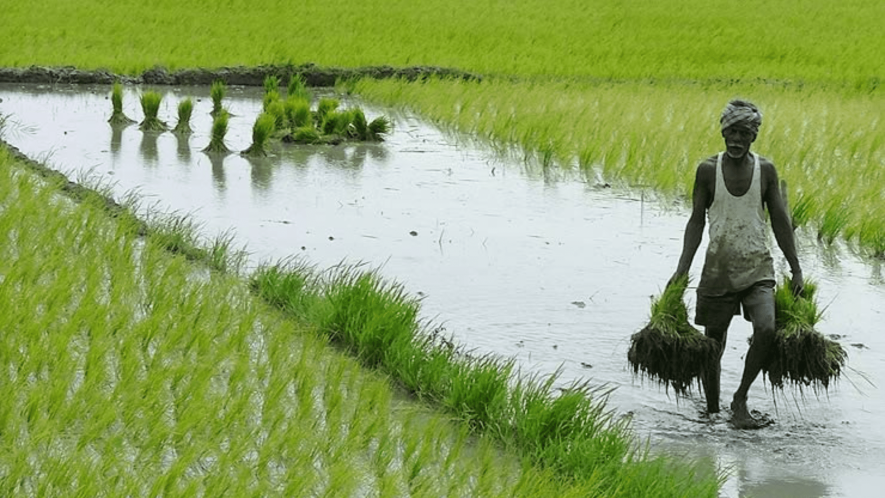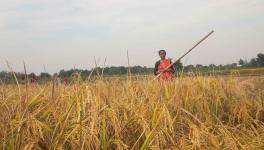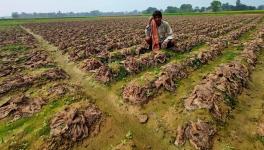Natural Farming Profitable, can Feed Country: Study

Image Courtesy: Wikimedia Commons
‘Mainstream’ agriculture in India is defined as farming with chemical-laced fertilisers and pesticides as inputs. Natural, organic, permaculture or no-till farming, a norm before the Green Revolution in the late 1960s, are all considered alternative farming techniques taken up by a privileged few who can afford to choose health over profits. But this alternative cannot feed the nation—or so is the perception.
Therefore, most government subsidies and schemes are directed towards chemical farming. The 2023 Budget for fertiliser subsidy was Rs 1.75 lakh crore against Rs 459 crore under the National Mission for Natural Farming.
However, a recent study focussing on the economic aspects of natural farming defies this logic. It says that natural farming gives better yield, more income for farmers, reduces the health cost for both farmers and consumers and increases social cohesion that ultimately loops back into an increase in productivity.
Released on July 19, the study, Natural Farming through a wide angle lens: True cost accounting study of community-managed natural farming in Andhra Pradesh, analysed the cost and benefits of natural farming against two other farming systems in the state. It found that natural farming can comfortably feed the community with nutritious food while addressing pressing environmental challenges like climate change, water scarcity, biodiversity loss, pollution and rural livelihood.
“Investment in natural farming delivers incredible returns on investment. Farmers engaged in natural farming do not get any fertiliser subsidy from the government thereby saving money for themselves and the country. But unfortunately, economists understand only private profits and not public gains,” said Pawan Sukhdev, CEO of GIST Impact, which led the study.
The study was commissioned by Global Alliance for the Future of Food, an association of philanthropic organisations working on the transformation of food systems.
“Using a true cost accounting framework, policymakers can now assess different farming systems on economic, social, environmental and human health indicators previously overlooked in conventional metrics focussed solely on yields and profits,” said Sukhdev.
The study uses The Economics of Ecosystem and Biodiversity (TEEB) for agricultural and food systems framework, developed by the United Nations Environment Programme to assess the economic value of services rendered by natural processes.
The Andhra Pradesh Community Natural Farming (APCNF) model is spread across 3,730 villages. A total of 1.2 million farmers and farmworkers have been reached, APCNF proponents Rythu Sadhikara Samstha (RySS), a non-profit company set up by the Andhra Pradesh government under Section 8 of the Companies Act, 2013, for farmers’ empowerment.
The basic tenets of community-based natural farming (CNF) include covering the soil with crops throughout the year, minimal disturbance of soil, and using inoculations and botanical extracts made from local inputs (like cow dung and urine) thereby eliminating the need for chemical fertilisers and pesticides, and using indigenous seeds, growing diverse crops and trees (15-20 crops), integrating animals in farming and increasing organic residue in the soil.
Study Findings
Between 2020 and 2022, the TEEB study authors surveyed 12 villages across three-different agroecological regions in Andhra Pradesh—the high-input chemical farming in the Krishna-Godavari Delta, low-input rainfed farming in the semi-arid region and low-input tribal agriculture in the mountain region and compared them with CNF farms in those regions.
The study found that CNF farms saw an average 11% increase in yields with average crop diversity going up from 2.1 to 4 crops in all three regions. For primary crops like paddy, maize, groundnut, finger millet and red gram, the average yield increase with the adoption of CNF ranges between 7.8%-26%.
CNF farmers had 44% lower input costs than counterfactual farms across the three regions as they shifted from synthetic to local inputs like seeds, compost and cow dung. As a result, the net income per hectare from CNF farms went up by 99%, according to the study.
On health indicators, the study revealed that CNF farmers lose 121 workdays annually due to illness compared to 189 days on other farms. Income loss due to health expense and wages lost for missing work in high-input Krishna Godavari farming areas was 26% higher than CNF farms in the same region.
The study found that the average diet of households practicing CNF has more macronutrient diversity than an Andhra food plate— indicating access to a wider range of food crops.
“For CNF villages, when deciding family diet, quality is the biggest driving factor (74%), followed by nutritional content (10%) and value for money (9%). In comparison, while non-CNF households’ diets are also driven by quality (55%), prices played a much larger role (28%) when deciding family diets,” it reads.
Social capital—defined by community cohesion, information sharing among farmers, sharing of expensive technologies (borewells, for instance), the role of gender and livelihood creation—something that smallholder farmers benefit more from than well-off farmers, was another aspect of the study’s focus.
“Farmers face many hurdles due to labour shortage, and the lack of quality seeds, technical know-how and irrigation facilities. It was seen that community cohesion had a strong and positive influence on productivity because labour and other resources are shared through collective action, reducing conflict and adding efficiencies. Farmers gain by cooperating rather than farming individually,” it says.
The APCNF model has its roots in the extensive women’s self-help group (SHG) network that preceded its formation in 2016. Even though women in Andhra are not directly involved in farm-related decisions, the study found that women are passive decision-makers who influence households to adopt CNF through information provided in SHGs.
CNF farms had increased labour requirements—up 21% across all farms—from 277 to 336 hours annually. “If the overall cost is less than chemical farming, it is only an advantage, allowing for increased employment in the rainfed areas,” said Vijay Kumar Thallam, executive vice-chairman of RySS.
THE WAY FORWARD
The APCNF model is based on training champion farmers who further work on creating the knowledge base of natural farming in villages—60% of these trainers are women.
“In 2016, we started with 800 champion farmers. Now, we have over 10,000. We have reached 14% of farmers in the last seven years, and we aim to cover 85% of farmers under CNF in the next seven years—77% of the RySS budget is for training champion farmers,” Thallam said.
APCNF is supported by funds from the Union Ministry of Agriculture and the Azim Premji Foundation among others. “The AP model is unique in that the state has a separate department of natural farming, which shows the state’s commitment. We also support Meghalaya, Rajasthan and Madhya Pradesh with best practices. Soon, eight states will be supported under a NABARD project. Many countries like Rwanda, Nepal, Indonesia and Sri Lanka have also approached us,” he said.
The Centre has announced a few schemes in this year’s Budget to support natural farming like the National Mission for Natural Farming—a scale-up of the Bharatiya Prakartik Krishi Paddati and the PM-PRANAM (Programme for Restoration, Awareness, Nourishment and Amelioration of Mother Earth) to incentivise a reduction in the use of chemical fertilisers but their implementation on the ground is slow.
“Apart from financial capital, natural farming generates knowledge, human and social capital—something not understood by economists,” said Sukhdev.
Agri-ecologists say that the report adds to the evidence that natural farming can feed the nation but needs to be followed up with government action to create a market for such produce.
“The current market for food crops has two to three layers between farmers and consumers where no real value addition is being done to the produce except for aggregation. The middlemen reap the profits of this aggregation with no benefit to the farmers,” said GV Ramajaneyulu, executive director of the Centre for Sustainable Agriculture, Hyderabad.
“The focus now should be on creating alternative markets where bulk consumers like office canteens, schools and temples are targeted. The premium on organic food will also decrease when the volume increases.”
The Tirumala Tirupati Devasthanam temple trust has recently approached the RySS as they want to serve meals made from the produce by CNF farmers.
Apart from markets, the government should incentivise farmers for bearing the clean-up cost of food systems, said Ramajaneyulu.
The current food systems are responsible for 45%-55% of greenhouse gas emissions and 70-90% of the total water available is used for them, Sukhdev said during the study’s launch.
Ten tonnes of carbon dioxide is released to produce 2.5 metric tonnes of rice. “With CNF, the emission is reduced by half. A farmer uses five bags of urea per acre with a subsidy of Rs 1,500 per bag plus water to grow paddy. If he shifts to the alternative System of Rice Intensification planting method, he will save Rs 7,500 in subsidy. Even if a part of this amount is given to the farmer in direct support, he will happily take to natural farming because that will create a buffer for him even if there is an initial yield loss by one to two quintals,” he said.
“We have the green credit programme today that incentivises environmentally sustainable processes. Why can’t natural farming be incentivised under that? In Andhra, it took 10 years to scale natural farming to this level. If the incentives are in place, it might take much lesser time in other states,” said Ramajaneyulu, who has worked on establishing the non-pesticide management system for crops in the state since 2003.
The CNF programme has been set up on the foundation of the women SHG and NPM programmes.
The report addresses externalities like health, biodiversity and pollution. “It shows that if these costs are internalised, the cost of chemical farming is way higher than natural farming. The report focusses on true ‘cost’ accounting but the aspect of true ‘price’ still needs to be worked upon,” said Ashish Gupta, social entrepreneur and expert on sustainable food systems.
“The economic aspect, the price that the farmer should be getting and what he is getting, has not been addressed in the report. However, it does mention that more needs to be done on the pricing aspect,” said Gupta, a consultant to the Himachal Pradesh government on sustainable food system designs.
“Food is a commonality across the world. All of us eat, which means we have a possible intake of chemicals two to three times a day. The cost of ecosystem services should be annotated in the price and all stakeholders—the market, consumers and middlemen—should pay for it. The price should not be ‘high’ but ‘true’,” he said.
The writer is an independent journalist working on rural and environmental issues.
Get the latest reports & analysis with people's perspective on Protests, movements & deep analytical videos, discussions of the current affairs in your Telegram app. Subscribe to NewsClick's Telegram channel & get Real-Time updates on stories, as they get published on our website.
























